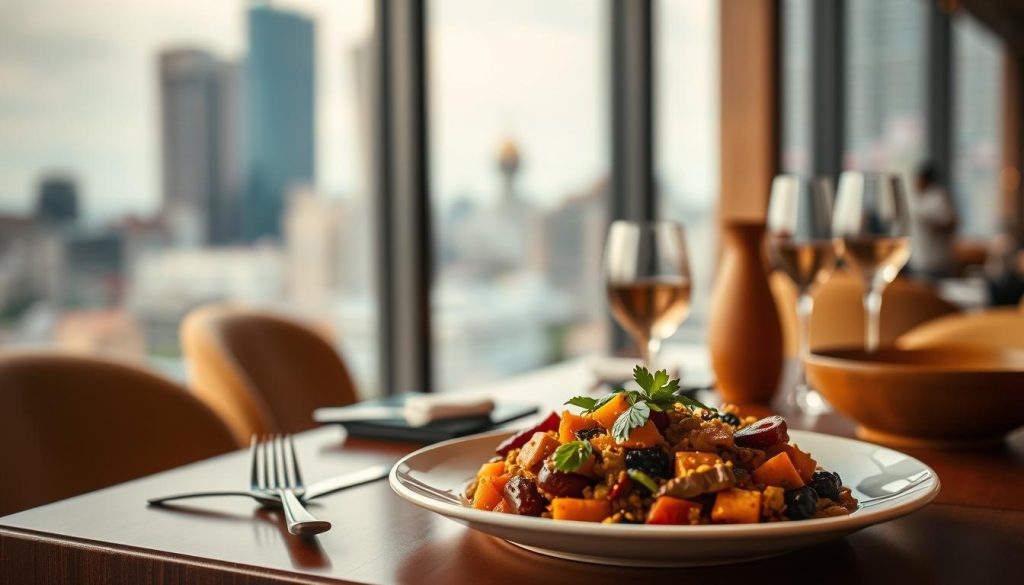African cuisine is a vibrant mix of the continent’s rich culture. It offers a wide range of street food and traditional dishes. Every palate finds something to love in African cuisine.
From spicy jollof rice in West Africa to flavorful tagine in North Africa, each area has its own dishes. African street food is a must-try for its unique flavors.
In this article, we’ll explore African cuisine’s rich flavors and traditions. Whether you’re a food lover or just curious, there’s something for everyone in African cuisine.
Introduction to African Cuisine
African cuisine mirrors the continent’s history, culture, and geography. It’s a feast for the senses with its diverse ingredients, cooking methods, and dishes.
Key Takeaways
- African cuisine is a diverse and vibrant reflection of the continent’s rich cultural heritage
- African street food offers a wide range of traditional dishes and flavors
- Each region in Africa has its unique culinary traditions and specialties
- African cuisine is a treasure trove of flavors, waiting to be explored and savored
- African street food and African cuisine have something to offer every palate
- African cuisine is a reflection of the continent’s history, culture, and geography
The Rich Heritage of Traditional African Cuisine
African food culture is vibrant and diverse, showing the continent’s rich heritage. It combines traditional ingredients with historical influences, attracting food lovers worldwide. Each region, from West Africa’s spicy flavors to North Africa’s aromatic tagines, has its own unique dishes.
Ingredients like rice, maize, and cassava are common in many African countries. They’re mixed with fruits, vegetables, and proteins to make tasty, healthy meals. This shows African cooks’ creativity and resourcefulness in making flavorful, sustainable food.
African food culture is more than just food. It’s about the people and traditions around it. Meals are times to come together and strengthen bonds. Sharing food shows hospitality and generosity, key parts of African culture.
Regional Variations
- West Africa: known for its spicy flavors and hearty stews
- North Africa: famous for its aromatic tagines and couscous dishes
- East Africa: home to a unique blend of African, Arab, and Asian influences
- South Africa: a melting pot of African, European, and Asian cuisines
Exploring traditional African cuisine helps us appreciate its diversity and complexity. Whether you’re a seasoned foodie or new to African cuisine, there’s always something exciting to try.
Essential Spices and Seasonings in African Cooking
African cooking is famous for its strong flavors and smells. This is thanks to key spices and seasonings. In West African cuisine, spices like cumin, coriander, and chili peppers are used. They add depth and heat to meals.
Some key spices and seasonings in African cooking techniques are:
- Garlic: adds a strong flavor to dishes
- Ginger: adds a spicy and warming flavor
- Berbere: a spicy chili powder mixture used in many African dishes
Knowing the importance of spices and seasonings in African cooking is key. It helps make dishes authentic and tasty. By using these essential spices and seasonings, you can enjoy the bold flavors and smells of West African cuisine and African cooking techniques.
Jollof Rice: West Africa’s Celebrated Dish
Jollof rice is a favorite in West Africa, loved for its history and cultural value. It’s a key dish at social events and celebrations. Its fame has grown, making it a top choice for African recipes.
This dish combines long-grain rice, tomatoes, onions, and spices for a tasty meal. The ingredients can change based on the country or region. But the core idea stays the same. For instance, some places add peppers or spices for a special taste.
- Long-grain rice
- Tomatoes
- Onions
- Spices (e.g., cumin, paprika)
- Peppers (optional)
Jollof rice is a must-try African recipe. It’s perfect for food lovers or those new to different cuisines. Its rich flavors and cultural importance make it a beloved dish in West Africa and worldwide.
Moroccan Tagine: A Taste of North Africa
North African cuisine is famous for its rich flavors and aromas. The Moroccan tagine is a perfect example. It’s a slow-cooked stew with meat, vegetables, and dried fruits. The dish is cooked in a clay pot with a conical lid.
This cooking method lets the flavors mix well, making a delicious meal. The spices like cumin, coriander, and cinnamon give tagine its unique taste. These spices are often mixed with ginger, garlic, and olive oil for a flavorful broth.
The slow-cooking tenderizes the meat, making it tender and full of flavor.
Some popular tagine variations include:
- Chicken tagine with preserved lemons and olives
- Beef tagine with prunes and apricots
- Vegetable tagine with chickpeas and spinach
These variations show the diversity of North African cuisine. Whether you want something hearty or light, there’s a tagine for you.
In North African cuisine, tagine is more than a meal. It’s an experience. The slow-cooking and traditional spices create a unique and delicious dish. So, why not try tagine and taste North Africa’s flavors for yourself?
Ethiopian Injera: The Soul of East African Food
In the heart of East African cuisine, injera is a key staple. It’s made from teff flour, water, and yeast. This gives it a sour taste and a spongy texture.
The dough is fermented for days, which makes injera unique. It’s a fundamental part of East African cuisine. It’s served with stews and dishes like wats and tibs.
Injera is at the center of Ethiopian meals. It’s used to scoop up other foods. Knowing its importance helps us understand its role in the region’s food culture.
Some key aspects of injera and its role in East African cuisine include:
- Traditional preparation methods, which involve fermenting the dough for several days
- Accompanying stews and dishes, such as wats and tibs, which are typically served with injera
- Cultural significance, as injera is a staple food in Ethiopian cuisine and plays a central role in meals
In East African cuisine, injera is more than food. It’s a symbol of hospitality and community. Sharing injera is a big part of Ethiopian dining. It brings people together, creating a sense of togetherness and shared experience.
Exploring Popular African Street Food Favorites
African street food is full of life and variety, showing off the continent’s rich food culture. You can find everything from spicy grilled meats to warm plantain dishes. A big hit is suya, Nigerian grilled meat skewers. They’re made with thin slices of beef or chicken, mixed with spices, peanut sauce, and ginger.
Other favorites include:
- Koshari, Egypt’s comfort food, made with pasta, lentils, and tomato sauce
- Alloco, Ivory Coast’s plantain delicacy, made with fried plantains and spices
These dishes are not just tasty but also carry deep cultural meaning. Trying suya or koshari lets you taste a piece of Africa’s heritage. So, dive into the world of African street food – your taste buds will love it!
South African Bobotie: A Cape Malay Classic
South African cuisine is a vibrant mix of cultures. Bobotie is a key dish that shows this diversity. It’s a meat pie with ground meat, spices, and dried fruits, topped with eggs.
Bobotie is a symbol of Cape Malay cuisine. It combines African, Asian, and European flavors. This mix creates a unique taste that’s truly South African.
Some key ingredients in bobotie are:
- Ground meat, typically beef or lamb
- A blend of spices, such as cumin, coriander, and turmeric
- Dried fruits, like raisins or cranberries
- A custard-like egg mixture, often flavored with milk and spices
Bobotie is more than a dish; it’s a piece of South Africa’s history. Its rich flavors and spices show the Cape Malay heritage. It’s a highlight of South African cuisine’s diversity.
Fufu and Soup: The Heart of Central African Dining
In Central Africa, fufu and soup are key parts of the local food. Fufu is made from boiled and pounded cassava, yam, or plantain. It’s often eaten with different soups. This combo shows community and welcome, as meals are shared with loved ones.
Types of Fufu
There are many kinds of fufu, each with its own taste and feel. Here are a few:
- Cassava fufu: made from boiled and pounded cassava
- Yam fufu: made from boiled and pounded yams
- Plantain fufu: made from boiled and pounded plantains
Traditional Soups
Traditional African soups use meat, fish, and veggies. Favorites include peanut soup, palm nut soup, and groundnut soup. These soups pair well with fufu, making a tasty and satisfying meal.
Modern Interpretations of African Recipes
African cuisine has changed a lot in recent years. Modern African cuisine is now vibrant and dynamic. It shows the continent’s rich culinary heritage. This change is thanks to fusion cuisine, which mixes traditional African ingredients with global flavors and techniques.
This shift has made modern African cuisine more diverse and exciting. There are now many innovative dishes and flavors to try.
The rise of fusion cuisine has brought unique and exciting dishes. Modern African chefs are trying new things. They use plant-based ingredients and Asian spices in traditional African dishes.
This mix of flavors and techniques has created a new culinary style. It’s a distinct and innovative style that is truly modern African cuisine.
Some trends in modern African cuisine include:
- Using traditional African ingredients in new ways, like fufu in vegan dishes
- Adding international flavors and spices, like Korean chili flakes and Indian curry powder, to traditional dishes
- The rise of fusion cuisine restaurants, which offer modern African dishes with global influences

Modern African cuisine is a vibrant and dynamic reflection of the continent’s culinary heritage. It offers a wide range of innovative dishes and flavors. As fusion cuisine becomes more popular, it will be exciting to see how modern African cuisine evolves.
Where to Find Authentic African Cuisine in America
African restaurants in America offer a wide variety of traditional dishes. You can taste the flavors of Africa right here. From spicy jollof rice to rich tagines, it’s a culinary adventure.
Many cities in America have African restaurants. Los Angeles has many Ethiopian spots, serving dishes like injera and wats. New York City is home to Nigerian cuisine, with places offering suya and egusi soup.
Some popular African restaurants in America include:
- Red Rooster in Harlem, New York, which serves African-American and African-inspired cuisine
- Berber Street Food in Los Angeles, which offers traditional Moroccan and North African dishes
- Accra Restaurant in Chicago, which serves Ghanaian and West African cuisine
These restaurants offer not just food but also a cultural experience. You’ll find everything from spicy West African dishes to flavorful North African tagines. African restaurants in America have something for everyone.
Conclusion: Embracing the Flavors of Africa
Exploring African cuisine is a journey of cultural discovery. We’ve seen dishes like Moroccan tagine and Ethiopian injera. Each dish shows the vibrant heritage and traditions of Africa.
By trying these dishes, we learn to appreciate African food culture. We see the innovative techniques, unique ingredients, and recipes that make it special.
We must keep highlighting African cuisine and the talented chefs who make it shine. By supporting local African restaurants and trying new dishes, we help preserve this culinary legacy. The flavors of Africa show the resilience, creativity, and ingenuity of its people. Embracing them enriches our culture.













